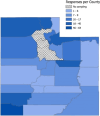Effects of religion, politics and distance to providers on HPV vaccine attitudes and intentions of parents in rural Utah
- PMID: 39441874
- PMCID: PMC11498715
- DOI: 10.1371/journal.pone.0312549
Effects of religion, politics and distance to providers on HPV vaccine attitudes and intentions of parents in rural Utah
Abstract
Purpose: Human papillomavirus (HPV) causes an estimated 300,000 high grade cervical dysplasias and 36,000 preventable cancers each year in the United States alone. Despite having a safe, effective and long lasting vaccine since 2006, the rate of uptake has been suboptimal, particularly in rural areas. In 2020, Utah ranked near last in teenage HPV vaccination rates with rural areas trailing urban areas by about 18 percent. In this study, we identified factors that affect the intent of rural Utah parents to vaccinate their children against HPV.
Methods: A survey was distributed electronically to Utah residents in rural areas. Recruitment was carried out through targeted advertising, community organizations, and professional survey panels. The survey was open from Nov. 15, 2022 to April 15, 2023. A total of 410 respondents were used for analysis. Survey results were analyzed using exploratory factor analysis, confirmatory factor analysis, and structural equation modeling.
Findings: Distance to care was shown to negatively influence direct intent to vaccinate, while trust in government, general vaccine attitudes, and HPV knowledge positively influence intent to vaccinate. It was found that religious practice decreased vaccine hesitancy while cautious sexual attitudes, distance to care, and general negative vaccine attitudes increased vaccine hesitancy. Conservative political identity and high income were both shown to decrease vaccine hesitancy as covariates.
Copyright: © 2024 Lee et al. This is an open access article distributed under the terms of the Creative Commons Attribution License, which permits unrestricted use, distribution, and reproduction in any medium, provided the original author and source are credited.
Conflict of interest statement
The authors have declared that no competing interests exist.
Figures






Similar articles
-
Identifying the intersection of parental HPV and COVID-19 vaccine hesitancy to inform health messaging interventions in community-based settings.Vaccine. 2024 Nov 14;42(25):126129. doi: 10.1016/j.vaccine.2024.07.030. Epub 2024 Jul 12. Vaccine. 2024. PMID: 38997849
-
Cautious Sexual Attitudes Diminish Intent to Vaccinate Children against HPV in Utah.Vaccines (Basel). 2022 Aug 24;10(9):1382. doi: 10.3390/vaccines10091382. Vaccines (Basel). 2022. PMID: 36146459 Free PMC article.
-
Parents' Intentions of Human Papillomavirus Vaccination for Students in Vietnam: A Cross-Sectional Study.Cancer Control. 2024 Jan-Dec;31:10732748241284907. doi: 10.1177/10732748241284907. Cancer Control. 2024. PMID: 39270069 Free PMC article.
-
HPV vaccine hesitancy in the United States.Curr Opin Pediatr. 2025 Apr 1;37(2):198-204. doi: 10.1097/MOP.0000000000001441. Epub 2025 Jan 22. Curr Opin Pediatr. 2025. PMID: 39882684 Review.
-
Sources of HPV vaccine hesitancy in parents.Hum Vaccin Immunother. 2013 Dec;9(12):2649-53. doi: 10.4161/hv.26224. Epub 2013 Aug 27. Hum Vaccin Immunother. 2013. PMID: 23982270 Free PMC article. Review.
References
MeSH terms
Substances
LinkOut - more resources
Full Text Sources
Medical
Miscellaneous

